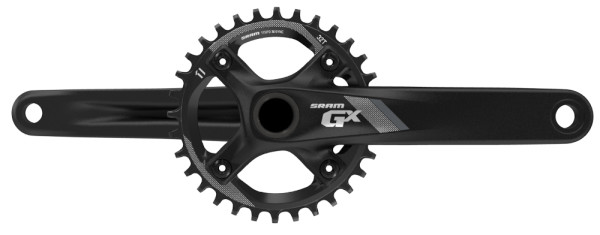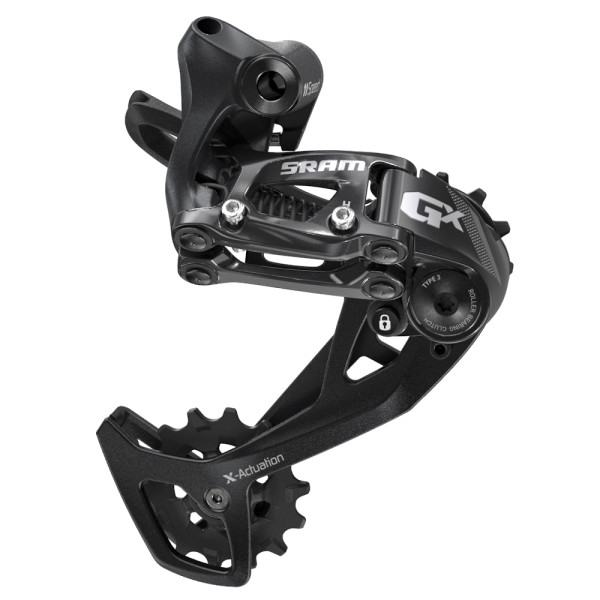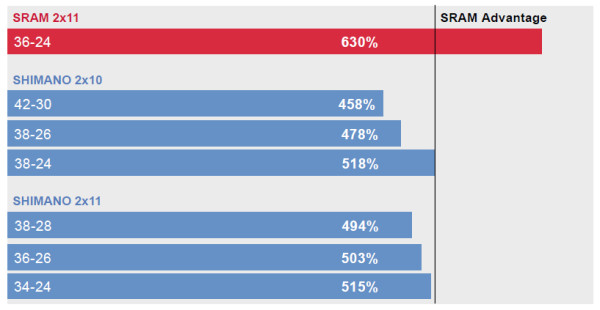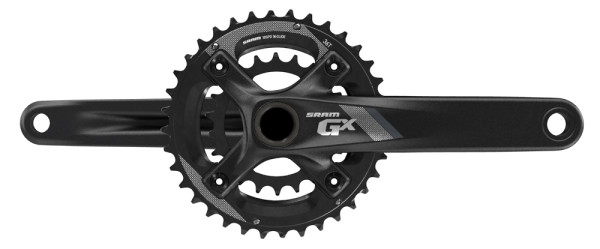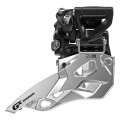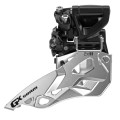What is the ideal mountain bike drivetrain? Well, that depends largely on who you ask, but it also varies greatly depending on what they’re riding. What works for an elite level athlete will likely not be the same system that works for your average weekend warrior. Throughout their most recent product releases, SRAM has invested heavily in the 1×11 concept which continues to gain traction. Lighter weight, no front derailleur, and a consistent chainring placement for bike engineers are all good things.
Realistically, having all the technology in the world won’t help you if your legs can’t push your bike up the next hill. While still banking on the 1×11 concept for a large portion of riders, SRAM is introducing an all new group that will have you ‘riding your way’ with their most affordable 1×11 group, plus an all new 2×11 drivetrain, and new 2×10 options as well…
Depending on who you ask, the new GX 1×11 group should be one of the highlights of the new product line. Using almost all of the same technology as X1, X01, and XX1, GX(1?) brings 1x drivetrains to a new level of affordability.
Regarding the gearing of 1x drivetrains, SRAM is quick to point out that they still offer the widest gear range in a head to head battle with Shimano. Of course, that wider gear range with the same number of gears will mean wider jumps between each individual cog. Ultimately the rider will have to decide what’s most important – short jumps making it easier to find the right gear for your cadence, or having the widest range of gearing possible.
Admittedly, the star of the new GX 1x group would have to be the cassette. Don’t get us wrong, the SRAM X-Dome cassettes are works of art, but when you’re talking about a wear item, anything over $300 can be hard for a large portion of consumers to swallow. To us, that’s why the new XG-1150 Full Pin Cassette is so exciting. Sure, it’s over 80g heavier than the X1 cassette (394g claimed vs 313g actual) , but it retails for just $144. That’s less than half of the price of an X1 cassette. To get the price of the cassette down to a more affordable level, the XG-1150 10-42 relies on a full steel construction with each cog held in place with 123 total stainless steel pins. The cassette still uses an open design for excellent mud shedding and offers the same gear range as its higher end siblings, just in a price most of us can afford.
Considering a GX 1x group can be retrofitted for just $302 for the shifter, rear derailleur, and wide range cassette, or $573 for the entire group, we expect to see a lot more of SRAM 1x drivetrains at the trail head. For reference, the cassette alone for the X1 group just one model up sells for $313. Other than using a SRAM PC-X1 chain, the GX 1x group includes all of the parts to make up a complete drivetrain including a fixed spider and removable spider crankset.
Inter-compatible with other SRAM 1x groups, the Full Pin cassette still utilizes the SRAM XD cassette body, and the cranksets will have Boost 148 compatible options.
GX 1x CRANKSET
- Open Core Technology AL (GX-1400 Crankset)
- 6000 series AL (GX-1000 Crankset)
- CNC machined 7075, two-tone anodized X-SYNC™ chainring (30-32-34-36-38)
- Bottom bracket configurations: PressFit 30, BB30, GXP, and PressFit GXP
- Chainring guard option
- Crank lengths: 175, 170
- Colors: Black, Red
- 24 and 30mm options
- Boost™ 148 compatible
- Technologies: X-SYNC™
- Weight: 680g (GX-1400, GXP, 175mm, 32t); 720g (GX-1000, GXP, 175mm, 32t)
GX 1×11 X-HORIZON™REAR DERAILLEUR
- X-HORIZON™ design reduces shift force, ghost shifting and chain slap
- 12-tooth X-SYNC™ pulley wheels
- Large upper pulley offset automatically adjusts chain gap
- Sealed cartridge bearings
- Aluminum cage
- Colors: Black, Red
- Technologies: X-HORIZON™, X-ACTUATION™, X-SYNC™, ROLLER BEARING CLUTCH™, CAGE LOCK™
- Weight: 265g
GX 11-SPEED TRIGGER SHIFTER
- SRAM 1x™ X-ACTUATION™ for precise and dependable 11-speed performance
- Multi-position mounting
- MatchMaker™ compatible
- Aluminum pull lever
- Discrete clamp
- Colors: Black, Red
- Technologies: X-ACTUATION™, MatchMaker™ Integrated
- Weight: 122g
XG-1150 FULL PIN™ CASSETTE
- 10-42T range
- XD™ driver body compatible
- Technologies: FULL PIN™, XD™ driver body, JET™
- Weight: 394g
The other really big news is the introduction of a 2×11 drivetrain that utilizes the SRAM wide range cassette. That cassette part is key – it required a completely revised rear derailleur to be able to handle the chainwrap and capacity, but it also provides some of the widest range mountain bike gearing available. Shimano’s 3×11 XTR drivetrain (22-30-40 x 11-40) is missing from the chart, but you get the picture. If SRAM’s 1x drivetrains don’t offer a wide enough gear range, the new GX 2×11 should have you covered.
In order to make the 2×11 drivetrain work with the current 10-42 cassette, the rear derailleur had to move away from the X-horizon design in favor of a more traditional slant parallelogram. Still using their X-Actuation 11 speed shift indexing, the derailleur uses a new Type 3 Roller Bearing Clutch and continues the use of Cage Lock.
GX 2×11 REAR DERAILLEUR
- X-ACTUATION™ for precise and dependable 11-speed performance
- Focused chassis design for all conditions and usage
- 10-42 wide range cassette compatible
- Colors: Black, Red
- Technologies: X- ACTUATION™, ROLLER BEARING CLUTCH™, CAGE LOCK™
- Weight: 289g (long cage), 286g (medium cage)
With the addition of 2×11, comes SRAM’s first left hand 11 speed trigger shifter which is a dedicated 2x system. You may have thought you had seen the last of SRAM front derailleurs (at least for 11 speed), but there it is. An X-Glide, X-Actuation front derailleur. Initially, GX 2×11 cranksets will only be available with a 36-24 gearing but that will probably change in the future.
GX 2×11 CRANKSET
- Open Core Technology AL (GX 1400 Crankset)
- 6000 series AL (GX 1000 Crankset)
- X-GLIDE™ 2×11 shifting technology
- Chainring option: 36-24
- Bottom bracket configurations: PressFit 30, BB30, GXP, and PressFit GXP
- Chainring guard option
- Crank lengths: 175, 170
- Colors: Black, Red
- 24 and 30mm options
- Boost™ 148 compatible
- Technologies: X-GLIDE™
- Weight: 727g (GX-1400, GXP, 175mm); 774g (GX-1000, GXP, 175mm)
GX 11-SPEED FRONT DERAILLEUR
- Wide range 2×11 systems with X-GLIDE™ front shifting technology
- High Clamp, Low Clamp, High Direct Mount, Mid Direct Mount, Low Direct Mount
- Dedicated top and bottom pull
- Technologies: X-ACTUATION™, X-GLIDE™
- Weight: 123-153g
GX 2×11 TRIGGER SHIFTERS
- Dedicated 2-speed and 11-speed trigger shifters
- X-ACTUATION™ for precise and dependable 11-speed performance
- Multi-position mounting
- Aluminum pull lever
- MatchMaker™ compatible
- Colors: Black, Red
- Technologies: X-ACTUATION™, MatchMaker™ Integrated
- Weight: 242g (per pair)
Whether you choose to run 1×11 or 2×11, both groups will have Grip Shifters as an option. Sold either as a single unit or the set, the shifters use most of the same technology found on other 11 speed Grip Shifts.
FEATURES / BENEFITS
- SRAM 1x™ X-ACTUATION™ for precise and dependable 11-speed performance
- Full metal, 11-speed indexing keeps shifting crisp and precise with Grip Shift
- Three rows of ball bearings provide zero friction or play—reducing the force needed to shift and promoting long-term performance under all weather conditions with Grip Shift
- Once the Grip Shift shifter and grip interlock securely, forged aluminum clamps on either end reinforce the assembly by locking tightly to handlebar
- Colors: Black, Red
- Technologies: X-ACTUATION™, SPEED METAL™, ROLLING THUNDER™, JAWS™
- Weight: 144g/286 per pair
Finally, there is the new GX 2×10 group. Essentially a replacement of SRAM x7 (assuming GX 2×11 is a replacement for X9), GX 2×10 gets a facelift over the previous generation and a few new tweaks. Relying on the current SRAM PG-1050 and PG-1030 cassettes, the GX 2×10 will not benefit from the wide range of the 11 speed cousins, but this is clearly the most budget friendly option in the group.
GX 2×10 CRANKSET
- 6000 series AL (GX 1000 Crankset)
- X-GLIDE™ 2×10 shifting technology
- Bottom bracket configurations: PressFit 30, BB30, GXP, and PressFit GXP
- Chainring options: 38-24, 36-22
- Chainring guard option
- Crank lengths: 175, 170
- Color: Black
- 24 and 30mm options
- Boost™ 148 compatible
- Technologies: X-GLIDE™
- Weight:799g (GXP, 175mm, 36/22)
GX 10-SPEED FRONT DERAILLEUR
- 2×10 systems with X-GLIDE™ front shifting technology
- High Clamp, Low Clamp, High Direct Mount, Low Direct Mount, Mid Direct Mount
- Dedicated top and bottom pull
- Technologies: X-GLIDE™, EXACT ACTUATION™
- Weight:134-161g
GX 2×10 REAR DERAILLEUR
- EXACT ACTUATION™ for precise and dependable 10-speed performance
- Cage lengths: Short, Medium and Long
- Color: Black
- Technologies: EXACT ACTUATION™, DIRECT ROUTE, ROLLER BEARING CLUTCH™, CAGE LOCK™
- Weight:302g (long cage with ROLLER BEARING CLUTCH™)
GX 2×10 TRIGGER SHIFTERS
- Dedicated 2-speed and 10-speed trigger shifters
- SRAM’s 2×10 EXACT ACTUATION™ for precise and dependable 10-speed performance
- Multi-position mounting
- MatchMaker™ compatible
- Aluminum pull lever
- Color: Black
- Technologies: EXACT ACTUATION™, MatchMaker™ Compatible
- Weight: 246g (per pair)
2×10 CASSETTES
PG-1050
- The PG-1050 cassette benefits from SRAM’s long history and expertise in developing cassettes. With its simple and reliable construction, it is the perfect cassette for the SRAM GX rider.
- Gear Ratios: 11-32, 12-32, 11-36, 12-36
- Technologies: PowerGlide II
- Weight: 299g (11-32T)
PG-1030
- PowerGlide technology provides super-smooth shifting between gears
- Gear Ratios: 11-32, 11-36
- Durable nickel chrome finish
- Technologies: PowerGlide
- Weight: 395g
Just when you thought the front derailleur was going away, GX comes along with a model for just about every standard. Both 2×10 and 2×11 drivetrains will have front derailleur models for High Clamp, Low Clamp, High Direct Mount, Low Direct Mount, and Mid Direct Mount with dedicated top and bottom pull derailleurs as well. Compatible with SRAM’s X-Glide front shifting technology, weights range from 123-153g (11 speed) and 134-161g (10 speed).
Pricing is as shown above with availability expected in June 2015 for GX 2×10, July for GX 1×11, and August for GX 2×11.






